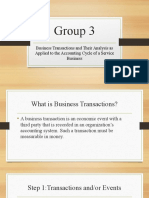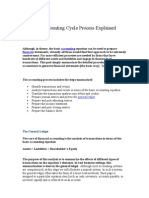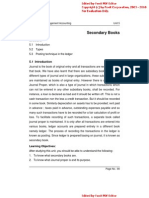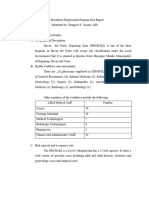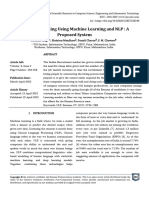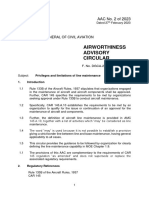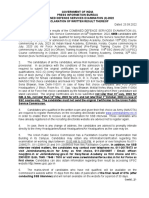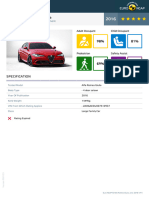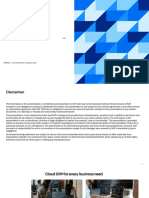0 ratings0% found this document useful (0 votes)
105 viewsLesson 5
Lesson 5
Uploaded by
Glenda DestrizaThe document summarizes the basic steps in the accounting cycle as: 1) Analyzing transactions, 2) Recording transactions in journals, 3) Posting transactions to ledgers, 4) Preparing an unadjusted trial balance, and 5) Making adjustments and journalizing adjusting entries. It provides examples to illustrate each step, explaining concepts like debits and credits, different types of accounts, and how the accounting equation is used to analyze effects of transactions. The overall purpose is to identify and record financial information in an organized way to eventually prepare financial statements.
Copyright:
© All Rights Reserved
Available Formats
Download as PPTX, PDF, TXT or read online from Scribd
Lesson 5
Lesson 5
Uploaded by
Glenda Destriza0 ratings0% found this document useful (0 votes)
105 views31 pagesThe document summarizes the basic steps in the accounting cycle as: 1) Analyzing transactions, 2) Recording transactions in journals, 3) Posting transactions to ledgers, 4) Preparing an unadjusted trial balance, and 5) Making adjustments and journalizing adjusting entries. It provides examples to illustrate each step, explaining concepts like debits and credits, different types of accounts, and how the accounting equation is used to analyze effects of transactions. The overall purpose is to identify and record financial information in an organized way to eventually prepare financial statements.
Original Title
lesson-5.pptx
Copyright
© © All Rights Reserved
Available Formats
PPTX, PDF, TXT or read online from Scribd
Share this document
Did you find this document useful?
Is this content inappropriate?
The document summarizes the basic steps in the accounting cycle as: 1) Analyzing transactions, 2) Recording transactions in journals, 3) Posting transactions to ledgers, 4) Preparing an unadjusted trial balance, and 5) Making adjustments and journalizing adjusting entries. It provides examples to illustrate each step, explaining concepts like debits and credits, different types of accounts, and how the accounting equation is used to analyze effects of transactions. The overall purpose is to identify and record financial information in an organized way to eventually prepare financial statements.
Copyright:
© All Rights Reserved
Available Formats
Download as PPTX, PDF, TXT or read online from Scribd
Download as pptx, pdf, or txt
0 ratings0% found this document useful (0 votes)
105 views31 pagesLesson 5
Lesson 5
Uploaded by
Glenda DestrizaThe document summarizes the basic steps in the accounting cycle as: 1) Analyzing transactions, 2) Recording transactions in journals, 3) Posting transactions to ledgers, 4) Preparing an unadjusted trial balance, and 5) Making adjustments and journalizing adjusting entries. It provides examples to illustrate each step, explaining concepts like debits and credits, different types of accounts, and how the accounting equation is used to analyze effects of transactions. The overall purpose is to identify and record financial information in an organized way to eventually prepare financial statements.
Copyright:
© All Rights Reserved
Available Formats
Download as PPTX, PDF, TXT or read online from Scribd
Download as pptx, pdf, or txt
You are on page 1of 31
Review of Financial Statement
Preparation, Analysis, and
Interpretation Pt.1
Specific Learning Outcomes At the end of
this lesson, the learners will be able to
identify and explain the basic steps in the
accounting process (accounting cycle).
Accounting is the systematic and comprehensive recording of
financial transactions pertaining to a business. (Investopedia -
Sharper Insight. Smarter Investing. | Investopedia. (2016).
Investopedia. Retrieved 8 May 2016, from
http://investopedia.com)
1. The Accounting Equation The basic accounting equation is:
ASSETS = LIABILITIES + OWNER’S EQUITY
Double entry bookkeeping - if we add something from the one
side, which is asset, we must add the same amount to the other
side to keep them in balance.
• For example, if we were to increase cash (an asset) we might
have to increase note payable (a liability account) so that the
basic accounting equation remains in balance.
ASSETS = LIABILITIES + OWNER’S EQUITY
P 500.00 P 500.00
• In double-entry bookkeeping, there is the concept of debit
(dr) and credit (cr). Debit is the left, and credit is the right.
• There is also a concept of normal balances. A normal
balance, either a debit normal balance or a credit normal
balance, is the side where a specific account increases.
• In the accounting equation, asset is on the left side, while
liabilities and equity is on the right side. Therefore, asset has a
debit normal balance, meaning that cash as an asset is
debited to increase, while credited to decrease.
• On the other hand, liabilities and owners’ equity have a
credit normal balance. This means that a liability account is
credited to increase, while debited to decrease. The
accounting equation provides the foundation for what
eventually becomes the balance sheet.
2. T-Account Analysis
In double-entry bookkeeping, the terms debit and credit
are used to identify which side of the ledger account an
entry is to be made. Debits are on the left side of the
ledger and Credits are on the right side of the ledger. It
does not matter what type of account is involved.
• The debit to cash increases the Cash Account by
PHP500 while the credit to Accounts Payable increases
this liability account by the same PHP500.
• In the above example, we analyzed the accounting
equation in terms of assets, liabilities, and owners’ equity.
These are called Real or Permanent Accounts. These
accounts remain open and active for the life of the
enterprise.
• In contrast, there are accounts that reflect
activities for a specific accounting period. These are
called Nominal or Temporary Accounts. After the
end of the specific period and the start of a new
period, the balance of the nominal accounts are
zero.
• Using the accounting equation, we can now
expand the analysis that will include both real and
nominal accounts. All nominal accounts will be then
closed to a Retained Earnings account at the end of
the period, which is an owner’s equity account.
Illustrative Example: Calvo Delivery Service is owned and
operated by Noel Calvo. The following selected
transactions were completed by Calvo Delivery Service
during February: A. Received cash from owner as
additional investment, P35,000. B. Paid creditors on
account, P1,800. C. Billed customers for delivery services
on account, P11,250. D. Received cash from customers on
account, P6,740.
3. Nominal Accounts
• There are two major categories of nominal accounts:
Expense and Revenue accounts. • Expense Accounts - A
resource, when not yet used up for the current period, is
considered an Asset and will provide benefits at a future
time. - On the other hand, a resource that has been used
for the current period is called an Expense. At the end of
each accounting period, expenses are closed out to the
Retained Earnings Account which decreases the Owners’
Equity. Since expenses decrease the owners’ equity, those
expense accounts carry a normal debit balance.
• Revenue Accounts - Revenue Accounts reflect the
accumulation of potential additions to retained earnings
during the current accounting period. - At the end of the
accounting period accumulation of revenues during the
period are closed to the Retained Earnings Account which
increases Owners’ Equity. - Therefore revenue accounts carry
a normal credit balance meaning the same balance as the
Retained Earnings Account.
Journalize the following transactions:
• Illustrative Example: J. F. Outz, M.D., has been a practicing
cardiologist for three years. During April 2009, Outz completed the
following transactions in her practice of cardiology:
Mar 1 Provide medical services to clients for cash P35,000.
Mar 2 Paid rent for the month, P3,000.
Paid advertising expense, P1,800.
Mar 6 Purchased office equipment on account, P12,300.
Mar 15 Paid creditor on account, P1,200.
Mar 27 Paid cash for repairs to office equipment, P500.
Mar 30 Paid telephone bill for the month, P180.
Mar 31 Paid electricity bill for the month, P315.
The Accounting Cycle
• Because accounting is all about getting data and
putting them into the accounting equation, the end
products are financial statements such as a balance
sheet and income statements, the process of
accounting follows a cycle called the Accounting
Cycle.
• It starts with the identification of whether a
transaction is accountable or can be quantified,
and ends with a post-closing trial balance.
The Process: Step 1: Analyze Business Transactions.
• In this step, a transaction is analyzed to find out if it affects the
company and if it needs to be recorded.
• Personal transactions of the owners and managers that do not
affect the company should not be recorded.
• In this step, a decision may have to be made to identify if a
transaction needs to be recorded in special journals such as a
sales or purchases journal.
• Therefore, what you should do is:
• A. Carefully read the description of the transaction to
determine whether an asset, a liability, an owner’s equity, a
revenue, an expense, or a drawing account is affected.
• B. For each account affected by the transaction, determine
whether the account increases or decreases.
• C. Determine whether each increase or decrease should be
recorded as a debit or a credit, following the rules of debit
and credit.
Example:
• N. Juna resigned from Company X.
• B. Cano purchased PHP500 cash worth of
supplies at Ace Hardware.
• Step 2: Record This in the Journal.
• Using the rules of debit and credit, transactions are initially entered
in a record called a Journal and the entry made is called a Journal
Entry.
• The journal serves as a record of when transactions occurred and
were recorded.
• For repetitive transactions or high volume transactions (e.g. one
thousand sales transactions in one day), Special Journals are made.
These special journals include sales journal, purchases journal, cash
receipts journal, and cash disbursements journal.
• The Source Document is the file or document (i.e. official receipt,
purchase order, contract) that will provide a basis or reason for a
journal entry. For example, an official receipt issued by the
business will tell you that a sale transaction occurred and will be
reflected by the journal entry.
Example:
• M. Jaya resigned from Company X.
• C. Danto purchased PHP500 cash worth of supplies to Ace
Hardware.
Step 3: Post the Transactions on a Ledger.
• A transaction is first recorded in a journal. Periodically, the journal
entries are transferred to the accounts in the ledger.
• The process of transferring the debits and credits from the journal
entries to the accounts is called Posting.
•Ledgers provide chronological details as to how transactions affect
individual accounts.
Two types of ledgers: the General Ledger and Subsidiary Ledger.
The general ledger is a summary of the different Subsidiary Ledgers
and can serve as a control account.
• For example, a general ledger for accounts receivable summarizes
the balances found in the different subsidiary ledgers for different
customers.
• Illustrative Example: J. Gaya, a CPA, is an independent auditor with
only two clients. The Accounts Receivable ledger account has a
balance of PHP100,000. His two clients are A. Rania, and X.
Campos. The subsidiary ledger of A. Rania has a balance of
PHP25,000. X. Campos’s ledger balance is PHP75,000. The sum of
subsidiary ledgers must total the general ledger or else there must
be an investigation to identify the source of discrepancies.
• Posting in the subsidiary ledgers can be done anytime and
the balances are summarized at the end of an accounting
period. Posting in the general ledger is done at the end of
an accounting period.
Step 4: Prepare an Unadjusted Trial Balance.
• Errors may occur in posting debits and credits from the
journal to the ledger. One way to detect such errors is by
preparing a trial balance.
• Double-entry accounting requires that debits must always
equal credits. The trial balance verifies this equality.
• The steps in preparing a trial balance are as follows:
1. List the name of the company, the title of the trial balance,
and the date the trial balance is prepared.
2. List the accounts from the ledger and enter their debit or
credit balance in the Debit or Credit column of the trial
balance.
3. Total the Debit and Credit columns of the trial balance.
4. Verify that the total of the Debit column equals the total of
the Credit column.
Step 5: Make adjustments. Journalize adjusting entries.
• At the end of the accounting period, many of the account balances in the ledger can
be reported in the financial statements without change.
• For example, the balances of the cash and land accounts are normally the amount
reported on the balance sheet. However, some accounts in the ledger require
updating.
• This updating is required for the following reasons:
1. Some expenses are not recorded daily. For example, the daily use of supplies
would require many entries with small amounts. Also, managers usually do not
need to know the amount of supplies on hand on a day-to-day basis.
2. Some revenues and expenses are earned as time passes rather than as separate
transactions. For example, rent received in advance (unearned rent) expires and
becomes revenue with the passage of time. Likewise, prepaid insurance expires and
becomes an expense with the passage of time.
3. Some revenues and expenses may be unrecorded. For example, a company may
have provided services to customers that are has not billed or recorded at the end of
the accounting period. Likewise, a company may not pay its employees until the next
accounting period even though the employees have earned their wages in the current
period.
• The analysis and updating of accounts at the end of the period
before the financial statements are prepared is called the Adjusting
Process. The journal entries that bring the accounts up to date at the
end of the accounting period are called Adjusting Entries.
• The following are normally adjusted at the end of a period: -
Accruals. These include unpaid salaries for the accounting period,
unpaid interest expense, or unpaid utility expenses.
Prepayments. If a company has prepaid expenses such as prepaid
rent or prepaid insurance then the correct balances for these
accounts have to be established at the end of each accounting period
to reflect their correct balances.
Depreciation and amortization expenses.
Depreciation expenses are recognized at the end of each accounting
period through adjusting entries. If there are intangible assets such
as franchise, the allocation of their costs which is called amortization
expense, is also recognized at the end of each accounting period
through adjusting entries.
Allowance for uncollectible accounts. Bad debt expense from
accounts receivable is also recognized through adjusting entries.
• Step 6: Prepare an Adjusted Trial Balance. An
adjusted trial balance is prepared after taking into
consideration the effects of the adjusting entries.
Again, this is to ensure that the total debit balances
equal the credit balances after posting and
journalizing adjusting entries made.
• Step 7: Prepare the financial statements. From the
adjusted trial balance, the financial statements can
then be prepared. These are the statement of
financial position, statement of profit or loss, and
the statement of cash flows
Step 8: Make the closing entries.
Nominal accounts (revenue and expense accounts) are closed to retained
earnings, or an owner’s capital account because these accounts refer only to a
specific accounting period. Actually, these accounts to be closed are accounts
that can be seen in the income statement.
• Upon closing: - If the revenues exceed expenses during an accounting
period, retained earnings will increase. - The reverse is true which means
that if the expenses exceed revenues, the retained earnings will decrease.
• In closing temporary accounts: - Revenue account balances are transferred
to an account called Income Summary Account (sometimes profit or loss
summary). - Expense account balances are also transferred to the Income
Summary Account. - The balance of the Income Summary (net income or
net loss) is transferred to the owner’s capital account. - The balance of the
owner’s drawing account is transferred to the owner’s capital account.
Step 9: Make a Post-Closing Trial Balance. A Post-Closing Trial Balance shows
the accounts that are permanent or real. These are the accounts that can be
seen in your balance sheet. The post-closing trial balance is prepared to test if
the debit balances equal the credit balances after closing entries are
considered.
5. Basic Financial Statements. A financial statement
is basically a summary of all transactions that are
carefully recorded and transformed into
meaningful information. It also shows the
company’s permanent and temporary accounts.
Basically, financial statements are comprised of the
following:
a. Income Statement
• These are also known as the Profit/Loss
Statement, Statement of Comprehensive Income,
or Statement of Income.
• This is a summary of the revenue and expenses
of a business entity for a specific period of time,
such as a month or a year.
b. Statement of Owner’s Equity
• These are also known as the Statement of Changes in
Equity.
• This reports the changes in the owner’s equity over a
period of time.
• It is prepared after the income statement because
the net income or net loss for the period must be
reported in this statement.
• Similarly, it is prepared before the balance sheet
since the amount of owner’s equity at the end of the
period must be reported on the balance sheet.
• Because of this, the statement of owner’s equity is
often viewed as the connecting link between the
income statement and balance sheet.
c. Balance Sheet
• also known as the Statement of Financial Position.
• This provides information regarding the liquidity
position and capital structure of a company as of a
given date.
• It must be noted that the information found in this
report are only true as of a given date.
• It shows a list of the assets, liabilities, and owner’s
equity of a business entity as of a specific date,
usually at the close of the last day of a month or a
year.
d. Statement of Cash Flows
• The statement of cash flows reports a company’s
cash inflows and outflows for a period.
• This is used by managers in evaluating past
operations and in planning future investing and
financing activities.
• It is also used by external users such as investors
and creditors to assess a company’s profit
potential and ability to pay its debt and pay
dividends.
1. Using the following (scrambled) accounts, prepare a balance sheet
for ABC, a retail company, for the year ending in December 31, 2014.
Assume that these are the only Balance Sheet Accounts.
2. Prepare a multi-step income statement for the retail
company, ABC, for the year ending December 31, 2014
given the information below:
You might also like
- Chapter 4 The Bookkeeping Process and Transaction AnalysisDocument17 pagesChapter 4 The Bookkeeping Process and Transaction AnalysisMarwa ElnasharNo ratings yet
- Operation & Service Manual: Model: 06-4035-3600 Hydraulic Service UnitDocument8 pagesOperation & Service Manual: Model: 06-4035-3600 Hydraulic Service UnitAlejo Guerra FernandezNo ratings yet
- Financial Statement PreprationDocument63 pagesFinancial Statement PreprationGraceann Casundo100% (2)
- Module Business Finance Chapter 2Document25 pagesModule Business Finance Chapter 2Atria Lenn Villamiel BugalNo ratings yet
- Business Finance - Grade 12Document4 pagesBusiness Finance - Grade 12althea bautistaNo ratings yet
- Business FInance Week 3 and 4Document75 pagesBusiness FInance Week 3 and 4Hyakkima NasumeNo ratings yet
- Business FInance Week 3 and 4Document68 pagesBusiness FInance Week 3 and 4Jonathan De villa100% (1)
- Business FInance Week 5 and 6Document51 pagesBusiness FInance Week 5 and 6Jonathan De villa100% (1)
- The Accounting Cycle: Step 1: Analyze Business TransactionsDocument4 pagesThe Accounting Cycle: Step 1: Analyze Business TransactionsUnkownamousNo ratings yet
- 2211posting 061cab6e3d56f89 03363994Document12 pages2211posting 061cab6e3d56f89 03363994Saleh RaoufNo ratings yet
- November 20, 2019 Lesson - FINANCIAL STATEMENT PREPARATIONDocument139 pagesNovember 20, 2019 Lesson - FINANCIAL STATEMENT PREPARATIONMarkus Bernabe Davira67% (3)
- Accounting CycleDocument21 pagesAccounting CyclebejeranoiankyletorresNo ratings yet
- Principle of Accounting Topic Is: Adjusting EntriesDocument11 pagesPrinciple of Accounting Topic Is: Adjusting EntriesAhsan azizNo ratings yet
- Accounting ProcessDocument79 pagesAccounting ProcessKeanna Ashley GutingNo ratings yet
- Steps in Accounting CycleDocument34 pagesSteps in Accounting Cycleahmad100% (4)
- Debits and CreditsDocument3 pagesDebits and CreditsLEIN JSNo ratings yet
- Business Transactions and Their Analysis As Applied ToDocument34 pagesBusiness Transactions and Their Analysis As Applied ToMichael AngeloNo ratings yet
- Accounting Cycle GuideDocument18 pagesAccounting Cycle GuideKarysse Arielle Noel JalaoNo ratings yet
- Financial Accounting PPTSDocument17 pagesFinancial Accounting PPTSsaliha mumtazNo ratings yet
- Class 9 - LedgerDocument19 pagesClass 9 - Ledger04shubhgoelNo ratings yet
- Explain Bank Reconciliation Statement. Why Is It PreparedDocument6 pagesExplain Bank Reconciliation Statement. Why Is It Preparedjoker.dutta100% (1)
- Accounting Financial: General LedgerDocument8 pagesAccounting Financial: General LedgerSumeet Kaur100% (1)
- LESSON 10 Business TransactionsDocument8 pagesLESSON 10 Business TransactionsUnamadable UnleomarableNo ratings yet
- Review of Financial Statements, Preparation, Analysis - Part 1Document12 pagesReview of Financial Statements, Preparation, Analysis - Part 1AnneNo ratings yet
- Principles of Accounting - Chapter 3 (1)Document39 pagesPrinciples of Accounting - Chapter 3 (1)Will Lorenz AmorantoNo ratings yet
- MBA 533 Lecture 2 Introduction To Financial Accounting BasicsDocument35 pagesMBA 533 Lecture 2 Introduction To Financial Accounting BasicsTrymore KondeNo ratings yet
- Group 3: Business Transactions and Their Analysis As Applied To The Accounting Cycle of A Service BusinessDocument25 pagesGroup 3: Business Transactions and Their Analysis As Applied To The Accounting Cycle of A Service BusinessPrincess Ariane CasioNo ratings yet
- Chapter IVDocument13 pagesChapter IVMariel OroNo ratings yet
- Introduction To Financial Accounting (FFA/FAB) : DR Ahmad AlshehabiDocument55 pagesIntroduction To Financial Accounting (FFA/FAB) : DR Ahmad AlshehabiKye SimpsonNo ratings yet
- Week 2 - Principle of AccountingDocument58 pagesWeek 2 - Principle of AccountingMai NgocNo ratings yet
- MBA 533 Lecture 2 Introduction To Financial Accounting BasicsDocument59 pagesMBA 533 Lecture 2 Introduction To Financial Accounting BasicsGlentonNo ratings yet
- One Full Accounting Cycle Process ExplainedDocument11 pagesOne Full Accounting Cycle Process ExplainedRiaz Ahmed100% (1)
- Chapter 2Document3 pagesChapter 2Jk DVSNo ratings yet
- 02-General Ledger AccountingDocument96 pages02-General Ledger AccountingFenniLim100% (2)
- Accounting CycleDocument21 pagesAccounting Cyclemuhammad.16032.acNo ratings yet
- MODULE 10-Lesson 1Document8 pagesMODULE 10-Lesson 1Rica Niña LetranNo ratings yet
- Trial Balance & Accounting ConceptsDocument32 pagesTrial Balance & Accounting ConceptsPaul Ayoma100% (1)
- Accounting Process PresentationDocument9 pagesAccounting Process PresentationKriyanshi PorwalNo ratings yet
- Course: Principles of Accounting and Economics Chapter 3: Accounting CycleDocument23 pagesCourse: Principles of Accounting and Economics Chapter 3: Accounting CyclemoallimNo ratings yet
- Accounts (1) FinalDocument28 pagesAccounts (1) FinalManan MullickNo ratings yet
- Unit - 1 (Hotel Accounts)Document19 pagesUnit - 1 (Hotel Accounts)Joseph Kiran ReddyNo ratings yet
- Financial Accounting Part 5Document19 pagesFinancial Accounting Part 5dannydoly100% (1)
- ACCT Service BusinessDocument5 pagesACCT Service BusinessFiona Chelsea MerinNo ratings yet
- Lec 3 Financial StatementsDocument60 pagesLec 3 Financial StatementsAyanChatterjee100% (1)
- Mod3 Part 1 Accounting Cyle For Service BusinessDocument21 pagesMod3 Part 1 Accounting Cyle For Service Businessviaishere4u100% (1)
- CH 2 Analyzing TransactionsDocument30 pagesCH 2 Analyzing TransactionsnabilafebionramadhaniNo ratings yet
- Accounting Handout 1Document3 pagesAccounting Handout 1Wahyu Gus PratamaNo ratings yet
- Accounting Cycle StepsDocument4 pagesAccounting Cycle StepsAntiiasmawatiiNo ratings yet
- Business Finance Module Week 2 3Document17 pagesBusiness Finance Module Week 2 3Camille CornelioNo ratings yet
- Accounting CycleDocument4 pagesAccounting Cycleddoc.mimiNo ratings yet
- 04 Accounting For Service BusinessDocument37 pages04 Accounting For Service Businesscarlo bundalian100% (1)
- Recording Business TransactionsDocument12 pagesRecording Business TransactionsAsh imoNo ratings yet
- Fundamentals of Accountancy Business and Management II 2nd QDocument14 pagesFundamentals of Accountancy Business and Management II 2nd QAnonymousNo ratings yet
- Accounting Cycle (Step 1 - 8)Document3 pagesAccounting Cycle (Step 1 - 8)Rachel Ann CapanzanaNo ratings yet
- Accounts PDFDocument46 pagesAccounts PDFArushi Singh100% (1)
- AccountingDocument13 pagesAccountingMae AroganteNo ratings yet
- Accounting Books - Journal, Ledger and Trial BalanceDocument35 pagesAccounting Books - Journal, Ledger and Trial BalanceGhie Ragat100% (3)
- Acctng 1 - 1st Lecture PDFDocument31 pagesAcctng 1 - 1st Lecture PDFJunlymar Rusiana CalumbaNo ratings yet
- Accounting MechanicsDocument21 pagesAccounting MechanicsPUTTU GURU PRASAD SENGUNTHA MUDALIAR100% (1)
- Financial Accounting - Want to Become Financial Accountant in 30 Days?From EverandFinancial Accounting - Want to Become Financial Accountant in 30 Days?Rating: 3.5 out of 5 stars3.5/5 (2)
- Providing Effective Supervision in Clinical NeuropsychologyDocument23 pagesProviding Effective Supervision in Clinical NeuropsychologyZamira BarguilNo ratings yet
- Exit ReportDocument3 pagesExit Reportponiozarlyn05No ratings yet
- Modal VerbsDocument16 pagesModal VerbsSoyun AnnayewNo ratings yet
- Resume Screening Using Machine LearningDocument7 pagesResume Screening Using Machine Learningjessen.535220023No ratings yet
- Edward John Miranda Resume 2012Document3 pagesEdward John Miranda Resume 2012Ry H. LopezNo ratings yet
- Resume Word OriginDocument5 pagesResume Word Originaflkvapnf100% (1)
- Heart Defect PDFDocument6 pagesHeart Defect PDFRosemaryCastroNo ratings yet
- Kaakkurinkierros: 26 KM Circle TrailDocument2 pagesKaakkurinkierros: 26 KM Circle TrailkarthhicNo ratings yet
- Aac02 2023Document6 pagesAac02 2023Sawan KumarNo ratings yet
- WR Cdsii 2022 Eng 230922Document24 pagesWR Cdsii 2022 Eng 230922manjeet singh sajwanNo ratings yet
- Science Fiction and The Future of CriticismDocument18 pagesScience Fiction and The Future of CriticismchnnnnaNo ratings yet
- Euroncap 2016 Alfa Romeo Giulia DatasheetDocument14 pagesEuroncap 2016 Alfa Romeo Giulia DatasheetmakkboyNo ratings yet
- The Plateau Star Anonang National High SchoolDocument16 pagesThe Plateau Star Anonang National High Schoolen619547No ratings yet
- Illustrated Parts Catalog FOR E-165, E-185 & E-225 Aircraft EnginesDocument42 pagesIllustrated Parts Catalog FOR E-165, E-185 & E-225 Aircraft Enginesr4airsalvageNo ratings yet
- Essence QuestionnaireDocument8 pagesEssence Questionnairerandolf wassigNo ratings yet
- Action of Catalase On Hydrogen PeroxideDocument4 pagesAction of Catalase On Hydrogen PeroxideRuchie Ann Pono BaraquilNo ratings yet
- Grade 5 Order of Adjectives BDocument2 pagesGrade 5 Order of Adjectives BJeffNo ratings yet
- Bright Wash-Safety Data SheetDocument8 pagesBright Wash-Safety Data SheetTariq khanNo ratings yet
- Offer: Atricure® ProductsDocument1 pageOffer: Atricure® ProductsAbdullah Ashour AlnimnimNo ratings yet
- EOT CRANE CONTROL DRAWING - Google SearchDocument14 pagesEOT CRANE CONTROL DRAWING - Google SearchElectrical2 GLOBAL ALUMINIUMNo ratings yet
- Sample 2Document12 pagesSample 2Ngô NgọcNo ratings yet
- American Academy of Clinical Neuropsychology (AACN) Practice Guidelines For Neuropsychological Assessment and ConsultationDocument24 pagesAmerican Academy of Clinical Neuropsychology (AACN) Practice Guidelines For Neuropsychological Assessment and ConsultationCarlos Jose De los Reyes AragonNo ratings yet
- L1 Solution Deck For SAP S4 HANA RetailDocument17 pagesL1 Solution Deck For SAP S4 HANA RetailbupeshNo ratings yet
- 5009 M.talha ProjectDocument11 pages5009 M.talha ProjectM.TalhaNo ratings yet
- Ts 5 Usbc 402Document29 pagesTs 5 Usbc 402German Ahumada ArancibiaNo ratings yet
- Burleigh 2Document3 pagesBurleigh 2Jim WestNo ratings yet
- Hasil EviewsDocument5 pagesHasil EviewsMutiaNo ratings yet
- UIDAI+ Paper+ +ver+1.1Document39 pagesUIDAI+ Paper+ +ver+1.1suneelrangamaniNo ratings yet
- 1.1.1 The Dynamic Nature of BusinessDocument6 pages1.1.1 The Dynamic Nature of BusinessryanNo ratings yet


























